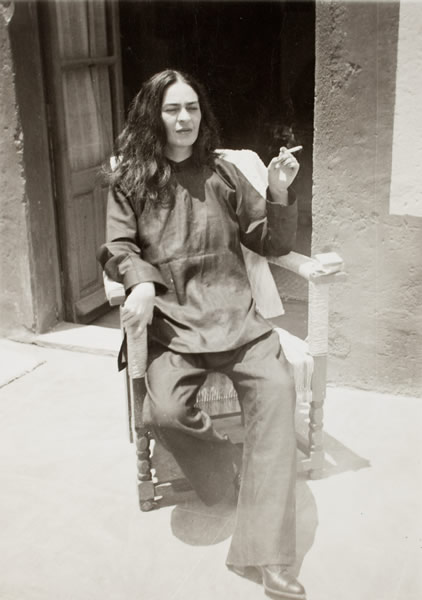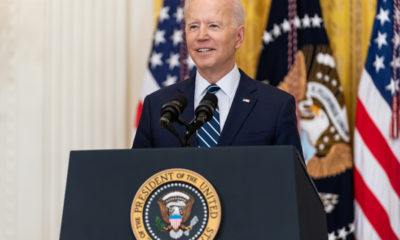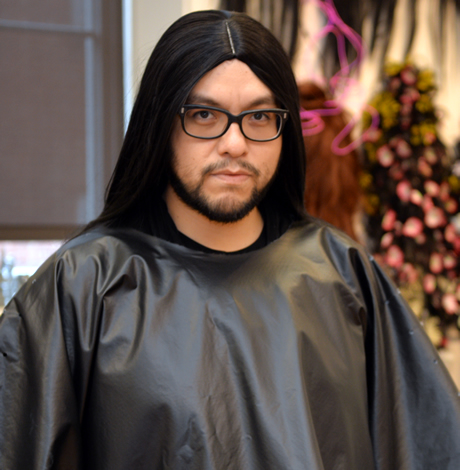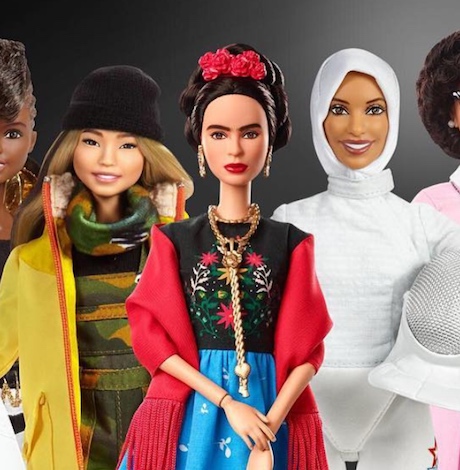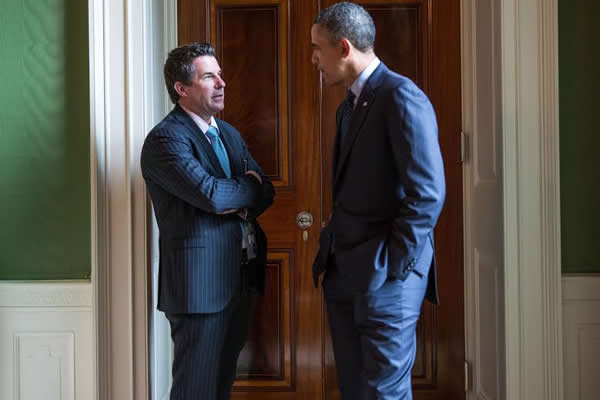Arts & Entertainment
Another side of a legend
Bi painter Kahlo’s photos displayed in new exhibit
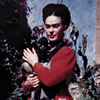
‘Frida Kahlo: Her Photos’
Artisphere
1101 Wilson Blvd.
Arlington, VA
Feb. 23-March 25
Fans of Frida Kahlo and students of photography in the D.C. area have a rare opportunity to see a collection of photographs that document and explore the fascinating life and rich legacy of this influential queer artist.
From Feb. 23 through March 25, Artisphere will be the only venue in the United States to show “Frida Kahlo: Her Photos,” an exhibition of personal photographs that have been hidden from public view since Kahlo’s death in 1954.
The extraordinary work of bisexual Mexican artist Frida Kahlo (1907-1954) is celebrated by a diverse group of dedicated fans. Best known for a series of stunning self-portraits that use costume and color to great effect, Kahlo is now seen as an important member of the surrealist movement. Artist André Breton hailed her work as a “ribbon around a bomb” and it’s admired in Mexico as an exploration of national and indigenous traditions. Feminists celebrate her painting as an uncompromising depiction of female bodies and lives and a powerful testament to her incredible strength in facing a life of chronic pain.
Writing in the online encyclopedia glbtq, queer cultural critic Tamsin Wilton also underscores the importance of Kahlo as a queer artist. During her long tempestuous marriage to famous activist and artist Diego Rivera, Kahlo had several affairs with both men and women. More artistically significant, however, is her bold use of costume to challenge traditional notions of female sexuality. Just as her depictions of ornate Mexican costumes were used to celebrate indigenous Amerindian culture, Wilton writes that Kahlo was often pictured in male attire to “make a statement about her own independence from feminine norms. She was a masterly and magical exponent of cross-dressing, deliberately using male ‘drag’ to project power and independence.”
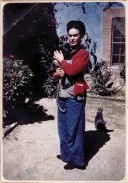 During her life, Kahlo created and collected more than 2,500 photographs from her international travels and from visitors to the house that she and Rivera shared. After Rivera’s death, in accordance with his will, this collection of snapshots was sealed and put in storage. In 2007, on the 50th anniversary of Rivera’s death, the collection was opened and cataloged by Mexican photographer and curator Pablo Ortiz Monasterio.
During her life, Kahlo created and collected more than 2,500 photographs from her international travels and from visitors to the house that she and Rivera shared. After Rivera’s death, in accordance with his will, this collection of snapshots was sealed and put in storage. In 2007, on the 50th anniversary of Rivera’s death, the collection was opened and cataloged by Mexican photographer and curator Pablo Ortiz Monasterio.
Monasterio has assembled 259 of these photographs into “Frida Kahlo: Her Photos,” which opens next week in Arlington. He has arranged the photographs into six thematic areas that align with the periods in Kahlo’s life. Each area was displayed in a separate room of the Blue House, a display that is recreated at Artisphere.
The first room, called Origins, documents the profound influence that Kahlo’s family had on her work. Her father Guillermo Kahlo, a German émigré, was a portrait photographer. He taught Frida the art of photography and trained her in the darkroom. Her mother, Matilde Calderón y Gonzalez, was a Roman Catholic with mixed Spanish and Amerindian heritage. The second room, The Blue House, explores Casa Azul, the Kahlo family home in Coyoacán Mexico, a sister city of Arlington, Va., where Frida was born, lived most of her life and died.
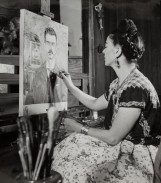 The third room, The Broken Body, displays photographs examining a central theme in Kahlo’s life and work, her serious physical injuries and her struggles with intense chronic pain. Kahlo contracted polio at age 6. As a result, her right leg was significantly thinner than her left. She often disguised this by wearing long skirts. In 1925, while she was a student in medical school, Kahlo was in a serious bus accident that left her with significant injuries, including multiple broken bones and internal injuries. These injuries made it impossible for her to bear children, a fact that haunted her for life. Over the course of 29 years, Kahlo endured 35 operations and suffered three miscarriages. She was frequently in intense pain and had to be bedridden or confined to a hospital for long periods.
The third room, The Broken Body, displays photographs examining a central theme in Kahlo’s life and work, her serious physical injuries and her struggles with intense chronic pain. Kahlo contracted polio at age 6. As a result, her right leg was significantly thinner than her left. She often disguised this by wearing long skirts. In 1925, while she was a student in medical school, Kahlo was in a serious bus accident that left her with significant injuries, including multiple broken bones and internal injuries. These injuries made it impossible for her to bear children, a fact that haunted her for life. Over the course of 29 years, Kahlo endured 35 operations and suffered three miscarriages. She was frequently in intense pain and had to be bedridden or confined to a hospital for long periods.
Kahlo began her career as an artist when she was in a body cast after her accident. Her mother designed a special easel for her and her father lent her paint and brushes. In addition to themes of national and sexual identity, her work often drew on images of bodily pain and expressed feelings of pain.
The fourth room of the exhibition is called Love and includes images of Kahlo’s family and friends, including her husband Diego and two of her male lovers. (The exhibition does not include any pictures of her known female lovers.) Cynthia Connelly, Artisphere’s Visual Arts Curator, is amazed by the incredible relationships Kahlo developed during her life.
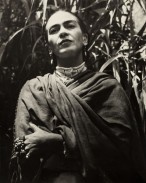 “When you walk through this room — and the entire exhibition — you get a sense of a really strong woman who surrounded herself with creative and challenging people,” Connelly says. “She lived a wonderful life and opened herself up to all kinds of ideas and experiences. She and Diego lived through so much history, but they were also creating history.”
“When you walk through this room — and the entire exhibition — you get a sense of a really strong woman who surrounded herself with creative and challenging people,” Connelly says. “She lived a wonderful life and opened herself up to all kinds of ideas and experiences. She and Diego lived through so much history, but they were also creating history.”
The fifth room, Photography, looks at the connection between Kahlo’s painting and her snapshot collection. Curator Ortiz traces several images, including a black cat and a dead baby, from Kahlo’s canvases back to their photographic origins. The sixth room, Diego’s Eyes, presents a series of photographs that directly and indirectly influenced Rivera’s huge political murals.
Connolly says those visiting the exhibition should be sure to read the photos’ descriptions, which contain a bounty of back story.
Each of the pictures is displayed with detailed information on the subject and artist (where they are known), date and media. In addition, Kahlo has left handwritten notes on the back of many of the snapshots, and in one case even left a lipstick print over an image of her husband Diego. Connolly also points out that the exhibit is a little like a mystery. “Each of the photographs fills in a little bit of her story,” she says, “but many of them bring up further questions and we can’t answer all of them for you. Pay attention to the details.”
These pictures also document an important moment in art history — the emergence of photography as a public art form. “In a time where almost everyone has a camera phone, we take photographs for granted,” Connolly says. “This was a time when photography was just coming into mass consumption. Snapshots were becoming less formal. Think about the kind of cameras being used and who processed the film.”
Given her skills in the darkroom, Kahlo may have developed many of them herself, though the photos shown at Artisphere are copies. Under the terms of Rivera’s will, the artifacts from Casa Azul are not allowed to leave Mexico. The local exhibition has been arranged in the same layout used by Monasterio in the original exhibition.
In addition to the historic photographs, the celebration of Frida Kahlo at Artisphere includes a variety of related events. There are two film series, one on women filmmakers (including Julie Taymor’s biopic “Frida” with Selma Hayek as the famous artist) and one featuring Robert Rodriguez; performances by flamenco artists, female salsa artists and the Mexican Institute of Sound; and hands-on workshops on surrealism.
Artisphere has produced this exhibition in collaboration with the Frida Kahlo Museum (Coyoacán, Mexico), Museo Diego Rivera Anahuacalli (Coyoacán, Mexico), the Embassy of Mexico, the Mexican Cultural Institute and Arlington County, with additional support from the Rosslyn Business Improvement District. This international collaboration was initially facilitated by the Arlington Sister City Association.
Bars & Parties
Mixtape Sapphics hosts holiday party on Dec. 13
‘Sugar & Spice’ night planned for Saturday
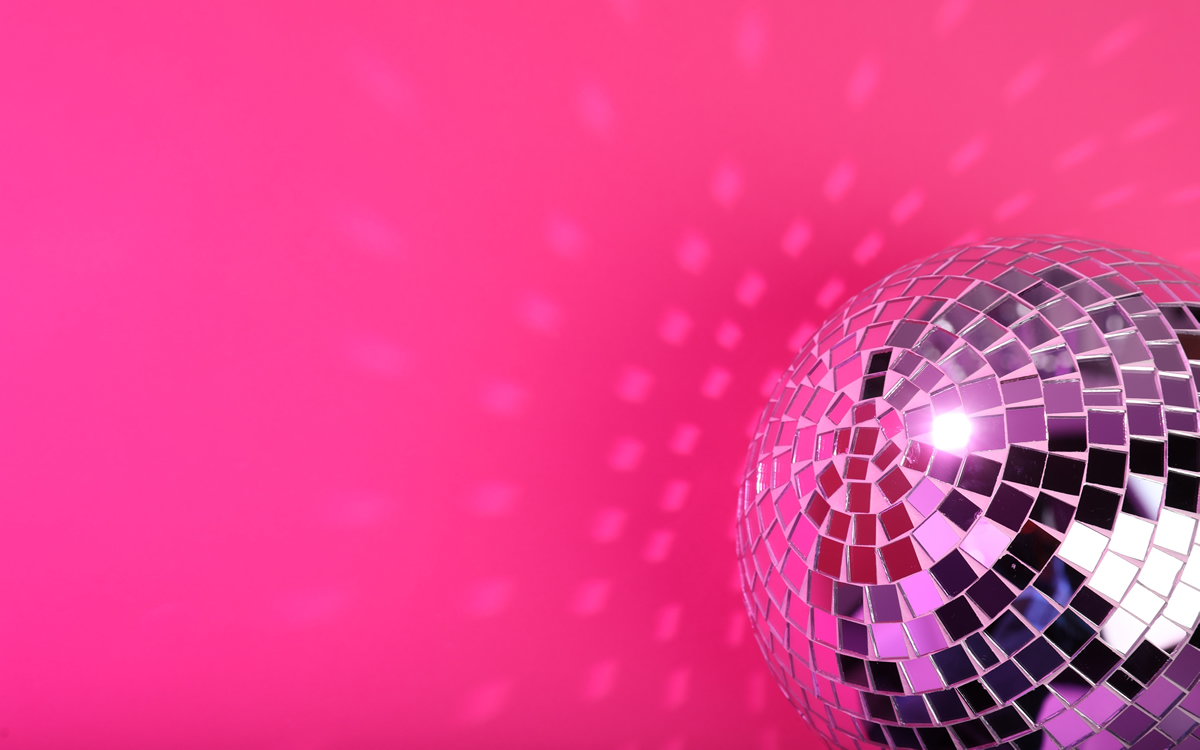
Mixtape Sapphics will host “Sapphic Sugar & Spice: A Naughty-Nice Mixtape Holiday Party” on Saturday, Dec. 13 at 4 p.m. at Amsterdam Lounge.
This is a festive, grown holiday party for queer women and sapphics 35 and older at Revolt’s Christmas pop-up. There will be music, joy, and an optional White Elephant.
This is Mixtape Sapphics’ first-ever holiday party — a cozy, flirty, intentionally grounded night created just for queer women and sapphics 35+ who want real connection, festive joy, and a warm place to land at the end of the year.
Tickets start at $13.26 and can be purchased on Eventbrite.

Friday, December 12
“Center Aging Friday Tea Time” will be at 12 p.m. in person at the DC Center for the LGBT Community’s new location at 1827 Wiltberger St., N.W. To RSVP, visit the DC Center’s website or email [email protected].
Go Gay DC will host “LGBTQ+ Community Happy Hour” at 7 p.m. at Freddie’s Beach Bar and Restaurant. This event is ideal for making new friends, professional networking, idea-sharing, and community building. This event is free and more details are available on Eventbrite.
Women in Their Twenties and Thirties will be at 8 p.m. on Zoom. This is a social discussion group for queer women in the Washington, D.C. area. For more details, go to Facebook.
Saturday, December 13
Go Gay DC will host “LGBTQ+ Community Brunch” at 12 p.m. at Freddie’s Beach Bar & Restaurant. This fun weekly event brings the DMV area LGBTQ+ community, including allies, together for delicious food and conversation. Attendance is free and more details are available on Eventbrite.
The DC Center for the LGBT Community will host “Sunday Supper on Saturday” at 2 p.m. D.C.’s queer community will gather for good food, laughter, and community. For more information, email [email protected].
Sunday, December 14
SADBrunch will host “HokiSlay Drag Brunch” at 12 p.m. at Throw Social. This festive affair brings fierce performances, over-the-top holiday looks, and more sparkle than a tinsel explosion. Expect powerhouse lip-syncs, laughter, and cheer hotter than your spiked cocoa. Cake Pop will host the event. Tickets cost $28.52 and are available on Eventbrite.
Monday, December 15
“Center Aging: Monday Coffee Klatch” will be at 10 a.m. on Zoom. This is a social hour for older LGBTQ+ adults. Guests are encouraged to bring a beverage of choice. For more information, contact Adam ([email protected]).
Genderqueer DC will be at 7 p.m. on Zoom. This is a support group for people who identify outside of the gender binary, whether you’re bigender, agender, genderfluid, or just know that you’re not 100% cis. For more details, visit genderqueerdc.org or Facebook.
Tuesday, December 16
Center Bi+ Roundtable will be at 7 p.m. on Zoom. This is an opportunity for people to gather and discuss issues related to bisexuality or as Bi individuals in a private setting. Visit Facebook or Meetup for more information.
The DC Center for the LGBT Community will host “Self-Defense Class with Avi Rome” at 12:30 p.m. Rome is a proud member of the LGBTQ community and a full-time martial arts instructor with 25 years of teaching experience. He holds a Fifth Degree Black Belt in Jhoon Rhee Tae Kwon Do and is the director of the studio’s Adaptive Tae Kwon Do program for students with special needs. He has also run numerous self-defense workshops for various groups and situations. For more details, visit the center’s website.
Wednesday, December 17
Job Club will be at 6 p.m. on Zoom upon request. This is a weekly job support program to help job entrants and seekers, including the long-term unemployed, improve self-confidence, motivation, resilience and productivity for effective job searches and networking — allowing participants to move away from being merely “applicants” toward being “candidates.” For more information, email [email protected] or visit thedccenter.org/careers.
Asexual and Aromantic Group will be at 7 p.m. on Zoom. This is a space where people who are questioning this aspect of their identity or those who identify as asexual and/or aromantic can come together, share stories and experiences, and discuss various topics. For more details, email [email protected].
Thursday, December 18
The DC Center’s Fresh Produce Program will be held all day at the DC Center for the LGBT Community. People will be informed on Wednesday at 5 p.m. if they are picked to receive a produce box. No proof of residency or income is required. For more information, email [email protected] or call 202-682-2245.
Virtual Yoga Class will be at 7 p.m. on Zoom. This free weekly class is a combination of yoga, breath work and meditation that allows LGBTQ+ community members to continue their healing journey with somatic and mindfulness practices. For more details, visit the DC Center’s website.
Egypt
Iran, Egypt object to playing in Seattle World Cup ‘Pride Match’
Game to take place on June 26
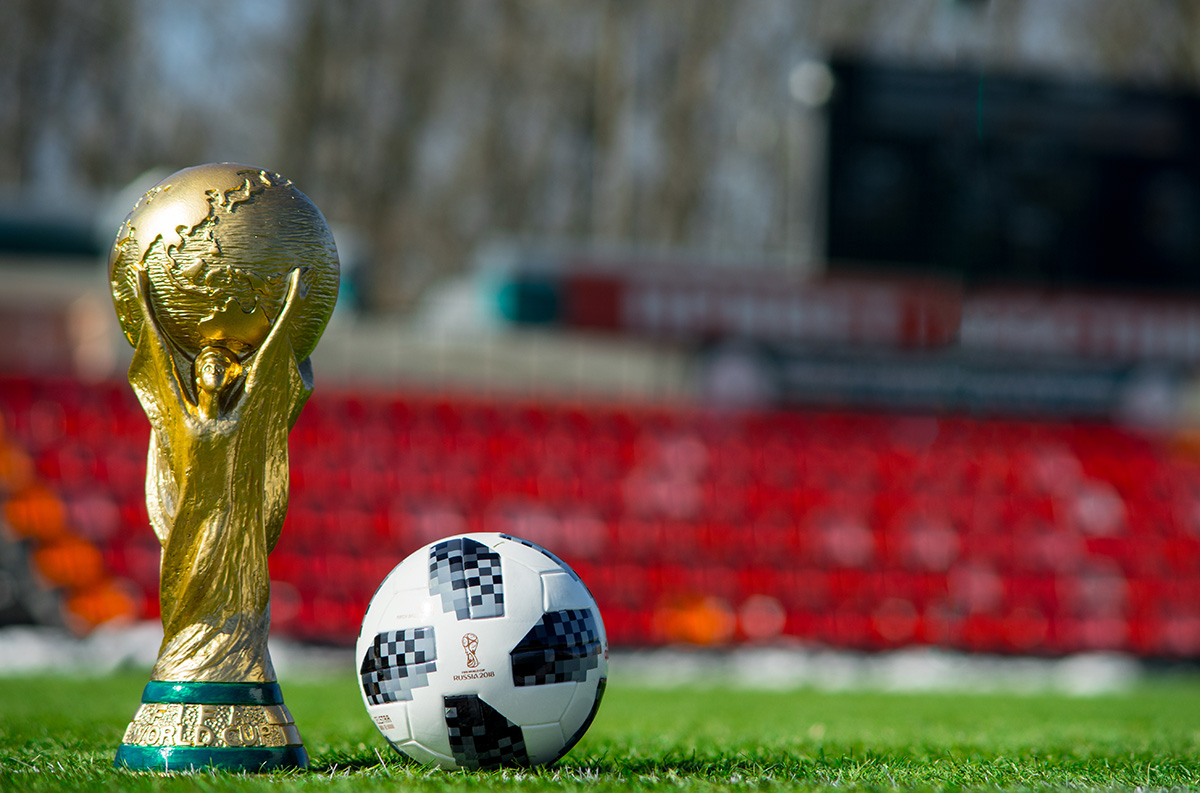
Iran and Egypt have objected to playing in a “Pride Match” that will take place in Seattle during the 2026 World Cup.
The Egyptian Football Association on Tuesday said it told FIFA Secretary General Mattias Grafström in a letter that “it categorically rejects holding any activities related to supporting (homosexuality) during the match between the Egyptian national team and Iran, scheduled to be held in Seattle, USA, on June 26, 2026, in the third round of the group stage of the 2026 World Cup.” Football Federation Islamic Republic of Iran President Mehdi Taj told ISNA, a semi-official Iranian news agency that both his country and Egypt “protested this issue.”
The 2026 World Cup will take place in the U.S., Canada, and Mexico. The draw took place at the Kennedy Center on Dec. 5.
Iran is among the handful of countries in which consensual same-sex sexual relations remain punishable by death.
The State Department’s 2023 human rights report notes that while Egyptian law “did not explicitly criminalize consensual same-sex sexual activity, authorities regularly arrested and prosecuted LGBTQI+ persons on charges including ‘debauchery,’ prostitution, and ‘violating family values.’” Egyptian authorities “also reportedly prosecuted LGBTQI+ individuals for ‘misuse of social media.’”
“This resulted in de facto criminalization of same-sex conduct and identity,” notes the report.
The 2024 human rights report the State Department released earlier this year did not include LGBTQ-specific references.
Soccer has ‘unique power to unite people across borders, cultures, and beliefs’
The June 26 match between Iran and Egypt coincides with Seattle Pride. The Washington Post reported the Seattle FIFA World Cup 2026 Local Organizing Committee decided to hold the “Pride Match” before last week’s draw.
“As the Local Organizing Committee, SeattleFWC26’s role is to prepare our city to host the matches and manage the city experience outside of Seattle Stadium,” said SeattleFWC26 Vice President of Communications Hana Tadesse in a statement the committee sent to the Washington Blade on Wednesday. “SeattleFWC26 is moving forward as planned with our community programming outside the stadium during Pride weekend and throughout the tournament, partnering with LGBTQ+ leaders, artists, and business owners to elevate existing Pride celebrations across Washington.”
“Football has a unique power to unite people across borders, cultures, and beliefs,” added Tadeese. “The Pacific Northwest is home to one of the nation’s largest Iranian-American communities, a thriving Egyptian diaspora, and rich communities representing all nations we’re hosting in Seattle. We’re committed to ensuring all residents and visitors experience the warmth, respect, and dignity that defines our region.”
The 2034 World Cup will take place in Saudi Arabia.
Consensual same-sex sexual relations remain punishable by death in the country. The 2022 World Cup took place in neighboring Qatar, despite concerns over the country’s anti-LGBTQ rights record.
-

 Congress20 hours ago
Congress20 hours agoEXCLUSIVE: George Santos speaks out on prison, Trump pardon, and more
-

 The White House5 days ago
The White House5 days agoTrump’s shocking East Wing amputation—and the painful fallout Americans won’t ignore
-

 Health4 days ago
Health4 days agoThe harsh truth about HIV phobia in gay dating
-

 District of Columbia5 days ago
District of Columbia5 days agoThird LGBTQ candidate running for Ward 1 D.C. Council seat

